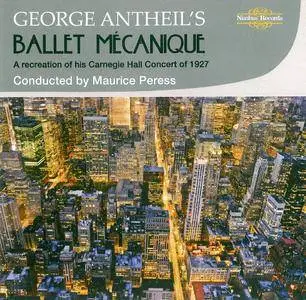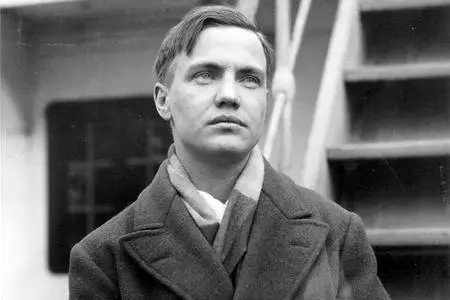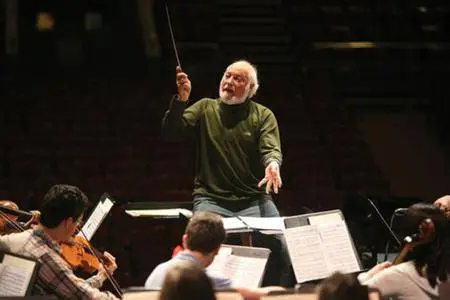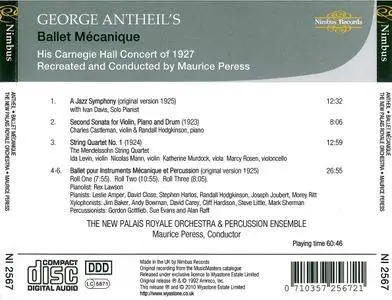George Antheil - Ballet Mécanique (1992) Reissue 2010
A Jazz Symphony; Second Sonata for Violin, Piano and Drum; String Quartet No.1
A recreation of the Carnegie Hall concert from 1927
The New Palais Royale Orchestra & Percussion Ensemble; conducted by Maurice Peress
Rex Lawson, pianola; Ivan Davis, piano; Mendelssohn String Quartet
Randall Hodgkinson, piano; Charles Castleman, violin
EAC | FLAC | Image (Cue&Log) ~ 298 Mb | Mp3 (CBR320) ~ 173 Mb | Scans included
Classical, Early Avant-Garde | Label: Nimbus | # NI 2567 | Time: 01:00:54
A Jazz Symphony; Second Sonata for Violin, Piano and Drum; String Quartet No.1
A recreation of the Carnegie Hall concert from 1927
The New Palais Royale Orchestra & Percussion Ensemble; conducted by Maurice Peress
Rex Lawson, pianola; Ivan Davis, piano; Mendelssohn String Quartet
Randall Hodgkinson, piano; Charles Castleman, violin
EAC | FLAC | Image (Cue&Log) ~ 298 Mb | Mp3 (CBR320) ~ 173 Mb | Scans included
Classical, Early Avant-Garde | Label: Nimbus | # NI 2567 | Time: 01:00:54
George Antheil's avant-garde signature piece, the Ballet Méchanique, created riots in Paris at the Theatre Champs Elysees in June of 1926, and the following April in New York's Carnegie Hall. Even though it was the focus of one of the most written about events in 20th century American music history, it was not to be heard again for 62 years, until American conductor and musicologist Maurice Peress searched out the original score and restaged the 1927 concert in the very same Carnegie Hall on July 12, 1989.
This world premiere recording now makes it possible to hear the original which contained Antheil's most advanced ideas; a futurist, machine-age, ragtime inspired music, of a complexity beyond human playing capabilities and a conception beyond most music composed in 1925.
The 1927 concert of George Antheil's music at Carnegie Hall, hyped by the New York press to a degree that seems unimaginable today ("Ballet Mécanique to Din Ears of New York – Makes Boiler Factory Seem as Quiet as Rural Churchyard"), was something of a fiasco. The audience responded to the airplane propellers in Ballet mécanique by throwing paper airplanes in the hall, and critic Deems Taylor famously hoisted a white flag on the end of a walking stick. Yet both Copland and Virgil Thomson considered Antheil a genius, and the memory of the concert never quite went away. Antheil made a new version of Ballet mécanique in the 1950s, losing the player piano parts and some of the electric bells, but keeping the airplane propellers and siren. Even the 1927 concert had backed off on some of the work's original specifications, which called for 16 player pianos. That version finally received its "world premiere" in 1999 in a computer realization at the University of Massachusetts, but the way was paved for it by the re-creation of the entire 1927 concert in 1990 by conductor Maurice Peress and his New Palais Royale Orchestra & Percussion Ensemble. That recording unfortunately disappeared with the demise of the MusicMasters label, and the Nimbus label has done a service by reissuing it. Several things may strike the listener familiar with the later Ballet mécanique. That work itself is an altogether noisier, bigger, and more effective thing than the 1950s revision, and you wonder whether the work might have failed at its premiere simply because it was imperfectly realized. Antheil condensed the music in the later version, and the climax of Roll Three, with all the pianos joining in with the siren and percussion, will make you jump out of your seat here. The rest of the music is also worth a revival, and now that several of the pieces have shown up on recordings multiple times it's time for concert performers to follow suit. A Jazz Symphony, of 1925, was originally composed for a planned-but-never-realized Second Experiment in Modern Music concert involving jazz bandleader Paul Whiteman, intended as a successor to the event that gave the world Rhapsody in Blue. Antheil clearly had Gershwin in mind with his jazz symphony and even includes a solo piano in the orchestration, but the work sounds nothing like Rhapsody in Blue, or any other work of the period, for that matter. It's sort of a constructivist treatment of jazz, with bits of jazz rhythm jammed together and sticking out from one another, and a pairing on a concert bill with Rhapsody in Blue would be a natural. Even rarer are Antheil's Second Sonata for violin, piano, and drum, which seems to indicate a greater influence from the music of Charles Ives than has generally been recognized during this period, and the somewhat Bartókian String Quartet No. 1. A superb effort all the way around, highly recommended to anyone with an interest in the 1920s American scene.Review by James Manheim, Allmusic.com
George Antheil was, probably, his own worst enemy. Having taken Paris by storm, both as composer and virtuoso pianist, he failed, unlike Stravinsky, to moderate his language and adopt the neo–classical style which came into vogue during his stay. However, when Copland arrived in France, to study, he said that “… George had all Paris by the ear". It was probably Ezra Pound’s call that Antheil was "possibly the first American–born musician to be taken seriously" and regarding him as the great Messiah of a 'New Music' which coloured the composer’s attitude. From our historical position, the fact that he failed to move with the times is no longer seen as a problem. True, some still find it difficult to equate Antheil’s early works with the more sober works he wrote after his return to the USA, but a man has to eat, and with a wife and son to support he had to work. The later works are, certainly, more conventional than the pieces from his Paris years, but there are still many fine pieces to be found, both in his concert music and operas as well as his music for film. I particularly like his score for Edward Dmytryk’s The Sniper (1952) and Ben Hecht’s Angels Over Broadway (1940). I cannot help but mention that before returning permanently to America, Antheil wrote a detective story, Death In the Dark, which was edited and published T.S. Eliot. The plot concerns the murder of a concert agent!
Antheil visited America in 1927 to display his musical wares to an unsuspecting American public and this is what it heard! He wrote the Jazz Symphony for Paul Whiteman’s second Experiment in Modern Music concert of December 1925 – the first, held on 12 February 1924, had introduced Rhapsody in Blue to the world. For some reason it wasn’t given in that show and the Carnegie Hall concert of 1927 was its premiere, when it was done by W.C. Handy’s Orchestra with the composer as piano soloist. Antheil revised the score of the Jazz Symphony in 1955 and made it a much less spectacular and exciting work. Hearing it in its original form is a revelation, for it is wild and exuberant, great fun and it’s easy to understand that it received an ovation when it was given in Carnegie Hall, at this concert. This is an excellent performance, hard-driven, up-front and in-yer-face, hysterical and brilliantly realised. It’s worth buying the disk for this piece alone.
Antheil’s two Violin Sonatas were written for Ezra Pound’s mistress, Olga Rudge. The second is fascinating for it contains a part for drum, supposedly written for Pound to play. As it stands, it starts as a wild ride for the two instruments, then the piano launches into an almost insane cadenza. After this the drum takes over the accompaniment for the rest of the work. As with most of the other music recorded on this disk, it’s a wild, typical 1920s piece, but the performance here is a bit too polite. I once turned pages for a performance of this work given by Thomas Halpern and Yvar Mikhashoff and they threw all caution to the wind, giving a marvellously showy and fantastically over-the-top performance – just what the work needs. All that kind of extrovert display is missing here. A real shame, given the music-making of the couplings.
The short 1 st String Quartet is a very compelling work, cogently written, well laid out for the instruments, and it’s much more mainstream European music than the other works recorded here. The performance, by the Mendelssohn Quartet, is strong and forthright.
The Ballet Mécanique made Antheil’s name and confirmed his status as ‘The Bad Boy of Music’ - the title of his autobiography which is well worth a read. It caused a riot at its premiere in Paris and Aaron Copland wrote to Israel Citkowitz, “… the boy is a genius. Need I add that he has yet to write a work which shows it.” At Carnegie Hall, Copland, together with Colin McPhee, was one of the pianists in the performance of the Ballet where, again, it caused a riot. In 1952 Antheil revised the score, but all this did was to water down a fascinating score into a less-than-interesting one. Here it is, in all its 1920s gaudy splendour, colossal, noisy, outrageous, a tough listen – without a doubt – but a rewarding one. Anyone who heard, either in the hall, or on the radio, the weak performance given at the 2009 BBC Proms won’t know what’s hit them when they hear this! It’s fantastic!
Great performances, in general, brilliantly bright sound, good notes all go to making this indispensable to anyone interested in American music and the musical experiments of the 1920s.Review by Bob Briggs, MusicWeb International
The New Palais Royale Orchestra & Percussion Ensemble (1, 4, 5, 6)
Conductor – Maurice Peress (1, 4, 5, 6)
Pianola – Rex Lawson (4, 5, 6)
Mendelssohn String Quartet (3)
Piano – Ivan Davis (1), Randall Hodgkinson (2)
Violin – Charles Castleman (2)
Recorded live at the Carnegie Hall, July 12, 1989
Tracklist:
01. A Jazz Symphony (original version 1925) (12:43)
02. Second Sonata for Violin, Piano and Drum (1923) (8:16)
03. String Quartet No.1 (1924) (13:04)
Ballet pour Instruments Mecanique et Percussion (original version 1925)
04. Roll One (7:53)
05. Roll Two (10:56)
06. Roll Three (8:04)
Exact Audio Copy V1.0 beta 1 from 15. November 2010
EAC extraction logfile from 17. January 2012, 21:38
George Antheil / Ballet Mecanique
Used drive : Optiarc DVD RW AD-7203A Adapter: 4 ID: 1
Read mode : Secure
Utilize accurate stream : Yes
Defeat audio cache : Yes
Make use of C2 pointers : No
Read offset correction : 48
Overread into Lead-In and Lead-Out : No
Fill up missing offset samples with silence : Yes
Delete leading and trailing silent blocks : No
Null samples used in CRC calculations : Yes
Used interface : Native Win32 interface for Win NT & 2000
Used output format : User Defined Encoder
Selected bitrate : 128 kBit/s
Quality : High
Add ID3 tag : No
Command line compressor : C:\Program Files\FLAC\flac.exe
Additional command line options : -T "COMMENT=Ripped by GFox" -8 -V %s
TOC of the extracted CD
Track | Start | Length | Start sector | End sector
––––––––––––––––––––––––––––-
1 | 0:00.37 | 12:42.60 | 37 | 57246
2 | 12:43.22 | 8:15.38 | 57247 | 94409
3 | 20:58.60 | 13:04.02 | 94410 | 153211
4 | 34:02.62 | 7:52.38 | 153212 | 188649
5 | 41:55.25 | 10:55.47 | 188650 | 237821
6 | 52:50.72 | 8:03.43 | 237822 | 274089
Range status and errors
Selected range
Filename D:\EAC\George Antheil - Ballet Mecanique.wav
Peak level 90.8 %
Extraction speed 0.5 X
Range quality 100.0 %
Test CRC 0AF65B9B
Copy CRC 0AF65B9B
Copy OK
No errors occurred
AccurateRip summary
Track 1 cannot be verified as accurate (confidence 1) [E4906DEE], AccurateRip returned [5C1E9455]
Track 2 cannot be verified as accurate (confidence 1) [B6C2A91D], AccurateRip returned [5C8E5746]
Track 3 cannot be verified as accurate (confidence 1) [F936E7DE], AccurateRip returned [C8858281]
Track 4 cannot be verified as accurate (confidence 1) [D08A5510], AccurateRip returned [2511B86B]
Track 5 cannot be verified as accurate (confidence 1) [0866E11A], AccurateRip returned [4BED2695]
Track 6 cannot be verified as accurate (confidence 1) [2FB8BE40], AccurateRip returned [DDACF0FB]
No tracks could be verified as accurate
You may have a different pressing from the one(s) in the database
End of status report
==== Log checksum FDAA7F0F5FA3D98221712C7244BA007E5B47C9DE06C26242C2570C0AE52A01A2 ====
EAC extraction logfile from 17. January 2012, 21:38
George Antheil / Ballet Mecanique
Used drive : Optiarc DVD RW AD-7203A Adapter: 4 ID: 1
Read mode : Secure
Utilize accurate stream : Yes
Defeat audio cache : Yes
Make use of C2 pointers : No
Read offset correction : 48
Overread into Lead-In and Lead-Out : No
Fill up missing offset samples with silence : Yes
Delete leading and trailing silent blocks : No
Null samples used in CRC calculations : Yes
Used interface : Native Win32 interface for Win NT & 2000
Used output format : User Defined Encoder
Selected bitrate : 128 kBit/s
Quality : High
Add ID3 tag : No
Command line compressor : C:\Program Files\FLAC\flac.exe
Additional command line options : -T "COMMENT=Ripped by GFox" -8 -V %s
TOC of the extracted CD
Track | Start | Length | Start sector | End sector
––––––––––––––––––––––––––––-
1 | 0:00.37 | 12:42.60 | 37 | 57246
2 | 12:43.22 | 8:15.38 | 57247 | 94409
3 | 20:58.60 | 13:04.02 | 94410 | 153211
4 | 34:02.62 | 7:52.38 | 153212 | 188649
5 | 41:55.25 | 10:55.47 | 188650 | 237821
6 | 52:50.72 | 8:03.43 | 237822 | 274089
Range status and errors
Selected range
Filename D:\EAC\George Antheil - Ballet Mecanique.wav
Peak level 90.8 %
Extraction speed 0.5 X
Range quality 100.0 %
Test CRC 0AF65B9B
Copy CRC 0AF65B9B
Copy OK
No errors occurred
AccurateRip summary
Track 1 cannot be verified as accurate (confidence 1) [E4906DEE], AccurateRip returned [5C1E9455]
Track 2 cannot be verified as accurate (confidence 1) [B6C2A91D], AccurateRip returned [5C8E5746]
Track 3 cannot be verified as accurate (confidence 1) [F936E7DE], AccurateRip returned [C8858281]
Track 4 cannot be verified as accurate (confidence 1) [D08A5510], AccurateRip returned [2511B86B]
Track 5 cannot be verified as accurate (confidence 1) [0866E11A], AccurateRip returned [4BED2695]
Track 6 cannot be verified as accurate (confidence 1) [2FB8BE40], AccurateRip returned [DDACF0FB]
No tracks could be verified as accurate
You may have a different pressing from the one(s) in the database
End of status report
==== Log checksum FDAA7F0F5FA3D98221712C7244BA007E5B47C9DE06C26242C2570C0AE52A01A2 ====
[CUETools log; Date: 05.07.2017 19:36:38; Version: 2.1.4]
Pregap length 00:00:37.
[CTDB TOCID: Q8kuQ7eV8.u6T8w8AajavrAWhmY-] found.
Track | CTDB Status
1 | (6/6) Accurately ripped
2 | (6/6) Accurately ripped
3 | (6/6) Accurately ripped
4 | (6/6) Accurately ripped
5 | (6/6) Accurately ripped
6 | (6/6) Accurately ripped
[AccurateRip ID: 000f579c-0050dcdd-430e4606] found.
Track [ CRC | V2 ] Status
01 [e4906dee|450a7eec] (0+4/8) Accurately ripped
02 [b6c2a91d|52b7a64f] (0+4/8) Accurately ripped
03 [f936e7de|9fcc9537] (0+4/8) Accurately ripped
04 [d08a5510|287ff300] (0+4/8) Accurately ripped
05 [0866e11a|d5d80601] (0+4/8) Accurately ripped
06 [2fb8be40|a1d3a5d5] (0+4/8) Accurately ripped
Offsetted by 18:
01 [b66592e9] (0/8) No match (V2 was not tested)
02 [05232070] (0/8) No match (V2 was not tested)
03 [29f84e42] (0/8) No match (V2 was not tested)
04 [5cbe7c45] (0/8) No match (V2 was not tested)
05 [740ea5ca] (0/8) No match (V2 was not tested)
06 [f1753a19] (0/8) No match (V2 was not tested)
Offsetted by 96:
01 [5c1e9455] (0/8) No match (V2 was not tested)
02 [5c8e5746] (0/8) No match (V2 was not tested)
03 [c8858281] (0/8) No match (V2 was not tested)
04 [2511b86b] (0/8) No match (V2 was not tested)
05 [4bed2695] (0/8) No match (V2 was not tested)
06 [ddacf0fb] (0/8) No match (V2 was not tested)
Track Peak [ CRC32 ] [W/O NULL] [ LOG ]
– 90,8 [0AF65B9B] [1A06A6A9] CRC32
01 86,3 [9A17C652] [7534AB3D]
02 66,1 [6E081C75] [B4299170]
03 70,2 [C51CCD7B] [2DAB9DEF]
04 90,8 [27954B32] [7855FC5C]
05 89,6 [36C1F572] [CDD88DEF]
06 85,1 [01D4F579] [DBEDBE14]
Pregap length 00:00:37.
[CTDB TOCID: Q8kuQ7eV8.u6T8w8AajavrAWhmY-] found.
Track | CTDB Status
1 | (6/6) Accurately ripped
2 | (6/6) Accurately ripped
3 | (6/6) Accurately ripped
4 | (6/6) Accurately ripped
5 | (6/6) Accurately ripped
6 | (6/6) Accurately ripped
[AccurateRip ID: 000f579c-0050dcdd-430e4606] found.
Track [ CRC | V2 ] Status
01 [e4906dee|450a7eec] (0+4/8) Accurately ripped
02 [b6c2a91d|52b7a64f] (0+4/8) Accurately ripped
03 [f936e7de|9fcc9537] (0+4/8) Accurately ripped
04 [d08a5510|287ff300] (0+4/8) Accurately ripped
05 [0866e11a|d5d80601] (0+4/8) Accurately ripped
06 [2fb8be40|a1d3a5d5] (0+4/8) Accurately ripped
Offsetted by 18:
01 [b66592e9] (0/8) No match (V2 was not tested)
02 [05232070] (0/8) No match (V2 was not tested)
03 [29f84e42] (0/8) No match (V2 was not tested)
04 [5cbe7c45] (0/8) No match (V2 was not tested)
05 [740ea5ca] (0/8) No match (V2 was not tested)
06 [f1753a19] (0/8) No match (V2 was not tested)
Offsetted by 96:
01 [5c1e9455] (0/8) No match (V2 was not tested)
02 [5c8e5746] (0/8) No match (V2 was not tested)
03 [c8858281] (0/8) No match (V2 was not tested)
04 [2511b86b] (0/8) No match (V2 was not tested)
05 [4bed2695] (0/8) No match (V2 was not tested)
06 [ddacf0fb] (0/8) No match (V2 was not tested)
Track Peak [ CRC32 ] [W/O NULL] [ LOG ]
– 90,8 [0AF65B9B] [1A06A6A9] CRC32
01 86,3 [9A17C652] [7534AB3D]
02 66,1 [6E081C75] [B4299170]
03 70,2 [C51CCD7B] [2DAB9DEF]
04 90,8 [27954B32] [7855FC5C]
05 89,6 [36C1F572] [CDD88DEF]
06 85,1 [01D4F579] [DBEDBE14]
foobar2000 1.2 / Dynamic Range Meter 1.1.1
log date: 2017-07-06 17:31:34
––––––––––––––––––––––––––––––––––––––––
Analyzed: George Antheil / Ballet Mecanique
––––––––––––––––––––––––––––––––––––––––
DR Peak RMS Duration Track
––––––––––––––––––––––––––––––––––––––––
DR15 -1.27 dB -21.38 dB 12:43 01-A Jazz Symphony (original version 1925)
DR14 -3.59 dB -22.13 dB 8:16 02-Second Sonata for Violin, Piano and Drum (1923)
DR16 -3.07 dB -26.24 dB 13:04 03-String Quartet No.1 (1924)
DR15 -0.84 dB -19.51 dB 7:53 04-Ballet pour Instruments Mecanique et Percussion (original version 1925) - Roll One
DR14 -0.95 dB -18.29 dB 10:56 05-Ballet pour Instruments Mecanique et Percussion (original version 1925) - Roll Two
DR14 -1.40 dB -20.88 dB 8:04 06-Ballet pour Instruments Mecanique et Percussion (original version 1925) - Roll Three
––––––––––––––––––––––––––––––––––––––––
Number of tracks: 6
Official DR value: DR15
Samplerate: 44100 Hz
Channels: 2
Bits per sample: 16
Bitrate: 606 kbps
Codec: FLAC
================================================================================
log date: 2017-07-06 17:31:34
––––––––––––––––––––––––––––––––––––––––
Analyzed: George Antheil / Ballet Mecanique
––––––––––––––––––––––––––––––––––––––––
DR Peak RMS Duration Track
––––––––––––––––––––––––––––––––––––––––
DR15 -1.27 dB -21.38 dB 12:43 01-A Jazz Symphony (original version 1925)
DR14 -3.59 dB -22.13 dB 8:16 02-Second Sonata for Violin, Piano and Drum (1923)
DR16 -3.07 dB -26.24 dB 13:04 03-String Quartet No.1 (1924)
DR15 -0.84 dB -19.51 dB 7:53 04-Ballet pour Instruments Mecanique et Percussion (original version 1925) - Roll One
DR14 -0.95 dB -18.29 dB 10:56 05-Ballet pour Instruments Mecanique et Percussion (original version 1925) - Roll Two
DR14 -1.40 dB -20.88 dB 8:04 06-Ballet pour Instruments Mecanique et Percussion (original version 1925) - Roll Three
––––––––––––––––––––––––––––––––––––––––
Number of tracks: 6
Official DR value: DR15
Samplerate: 44100 Hz
Channels: 2
Bits per sample: 16
Bitrate: 606 kbps
Codec: FLAC
================================================================================









